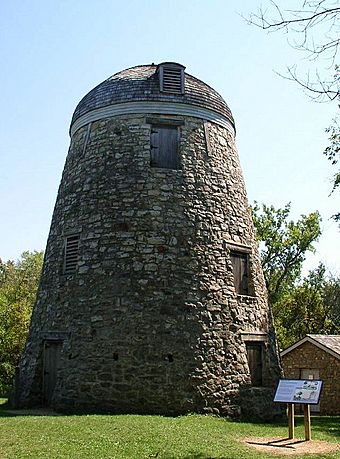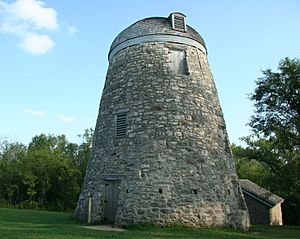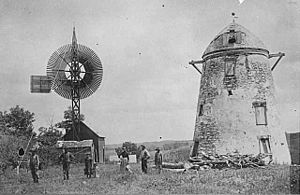Seppman Mill facts for kids
Quick facts for kids |
|
|
Seppmann Mill
|
|

The Seppmann Mill and adjacent granary
|
|
| Location | MN 68 in Minneopa State Park |
|---|---|
| Nearest city | Mankato, Minnesota |
| Built | 1864 |
| Architect | Louis Seppmann |
| MPS | Blue Earth County MRA (AD) |
| NRHP reference No. | 71000435 |
| Added to NRHP | August 26, 1971 |
The Seppmann Mill is an old windmill located in Minneopa State Park in Blue Earth County, Minnesota. A German immigrant named Louis Seppmann built it between 1862 and 1864. This historic mill is now listed on the National Register of Historic Places. Today, its large sails and inner workings are no longer there.
Contents
Building a Wind-Powered Mill
Louis Seppmann was born in Westphalia, Germany, in 1835. When he was 17, he moved to the United States. Five years later, in 1857, he settled in Blue Earth County, Minnesota. Louis worked as a stonemason, building things with stone.
In 1862, he used his earnings to start building a gristmill on his own land. A gristmill uses power to grind grain into flour. Louis knew a little about windmills from his home country. He also had a great natural talent for building and inventing things.
Louis, with help from other stonemasons, built the first 10 feet (3 meters) of the walls. But then he faced money problems and the start of the Dakota War of 1862. He had to stop working on the mill.
He started again the next summer, joined by his neighbor, Herman Hegley. They used a ramp and a wheelbarrow to move materials up the growing structure. They finished building the mill in 1864. Louis carved most of the wooden parts himself with an axe. Only two metal gears and the heavy millstones had to be bought. They cost $600, which was a lot of money back then!
What the Mill Looked Like
The mill's stone walls are 32 feet (9.75 meters) high and shaped like a cone. At the bottom, the mill is 30 feet (9.14 meters) wide, and its walls are 2 feet (0.61 meters) thick. As the walls go up, they get narrower, becoming 20 feet (6.1 meters) wide and 6 inches (15 cm) thick at the top.
The mill had a wooden dome roof that could turn. This allowed the miller to point the sails into the wind. There was a small platform outside the dome where the miller liked to sit and smoke his pipe. The long wooden arms, covered with sailcloth, stretched 72 feet (21.9 meters) across. Inside, the mill had five floors, though some were very short and only held machinery.
Getting the Mill Started
Louis Seppmann was not a farmer. To test his new mill, he had to borrow money to buy grain. This was during the American Civil War, so grain was very expensive. The bank even charged him 25% interest on his loan!
Louis also needed to hire an expert to help him start the mill and teach him how to use it. But for four or five weeks, there was no wind. The expert eventually gave up and went home. The first light wind finally blew on a Sunday. Louis didn't want to work on the Sabbath, but his partner Hegley convinced him. He said if God sent the first wind in over a month on a Sunday, it must be okay.
Without the expert's help, Louis and Hegley quickly clogged the millstone. They thought more speed would help, so they put on full sail. But the wind grew stronger, making the arms spin so fast they couldn't stop it! The wooden parts got so hot that the windmill was in danger of catching fire.
Meanwhile, a crowd of people had gathered outside. They were excited to see Louis's amazing mill finally working. They were also surprised it was running so fast it looked like it might break apart! In a panic, Louis threw something into the gears. It shattered, and a piece flew off with such force that it shot a hole through the rim of his hat!
Finally, Louis and Hegley managed to unfurl some of the sails and stop the mill. They learned that the clog was because the millstones weren't prepared correctly. After making improvements, including a better brake, the mill was ready to operate by late September.
How the Mill Worked
When the wind was good, the mill could grind 150 bushels of wheat in a day. It produced good quality flour. Farmers traveled from as far as 30 miles (48 km) away to have their grain milled.
In 1866, Louis Seppmann got married. He bought out his partner Hegley and gave shares of the mill to his new in-laws instead. The Seppmanns first lived in a small stone house next to the windmill. In the 1870s, after they moved to a new home, this small house became a warehouse.
In June 1873, Lightning struck the mill, blasting off two of its arms. Louis replaced them. But seven years later, a tornado knocked off two arms again. By then, new technology and other mills made it too expensive to repair. Louis kept operating the mill with the two remaining arms, grinding animal feed. Finally, a storm in 1890 damaged the last arms, and Louis stopped using the mill.
The Mill's Later Years
Over the next 40 years, the mill slowly fell apart. The warehouse next to it was completely torn down. In 1929, Louis Seppmann's son, Alfred, gave the windmill to be added to Minneopa State Park.
The Blue Earth County Historical Society made repairs before the 1.24-acre (0.5-hectare) piece of land was given to the state in 1931.
The mill site was originally more than a mile away from the main state park, making it hard for people to visit. The Minnesota State Highway Department built a parking area off Highway 68 in the mid-1950s. In the late 1960s, Louis Seppmann's family and other landowners sold the land between the mill and the park. This allowed the park to grow into one connected property.
The Minnesota Department of Natural Resources spent $65,000 to repair the mill and rebuild the warehouse. The outside of the mill was fixed, the inside structures were made new, doors and windows were replaced, and the roof got new shingles.
Today, the mill's inner machinery has been taken apart. Neither the mill nor the warehouse interiors are open to the public. Park managers hope to restore the machinery and the arms someday.
Images for kids




